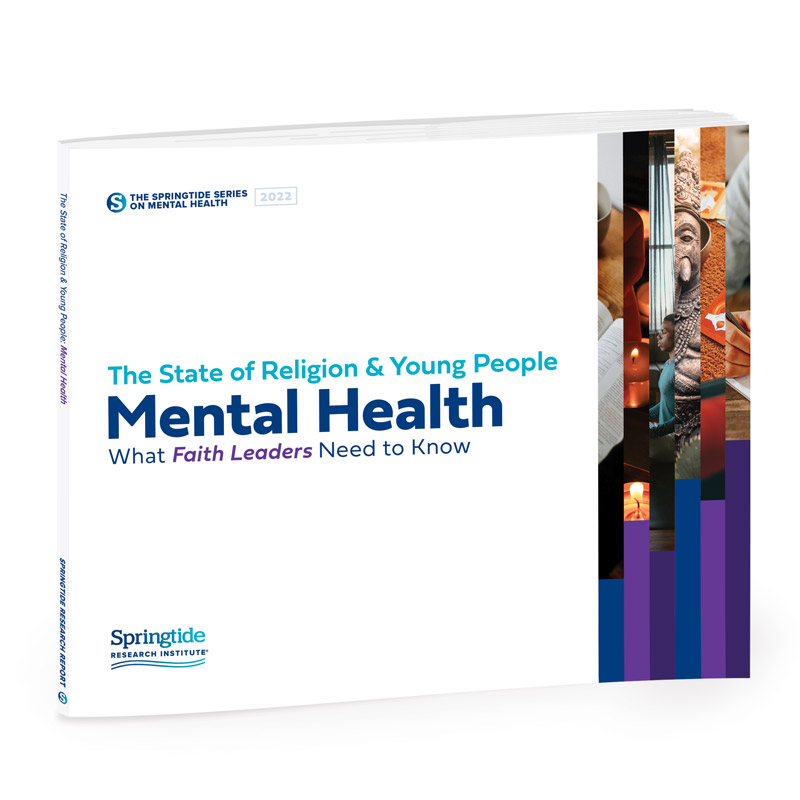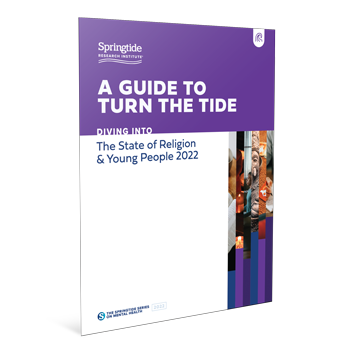The State of Religion & Young People 2022: Mental Health — Resources

The resources referenced in numbered marginal notes in The State of Religion & Young People 2022 can be found at the bottom of this page.
In the Key Findings section we presented data that is intended to offer faith leaders a sense of the big picture—larger trends that shed light on the religious and spiritual lives of young people at a time when so many report struggling with their mental health. Directly below are additional breakdowns of some of the findings reported in that section.
Toggle back and forth on the data below to see different spreads of data according to age, present religion, race, and gender by clicking the boxes on the left-hand side of the graphics.
Key Findings — Additional Data by Age, Present Religion, Race & Gender
Disclaimer: The following dashboards were designed to enable audiences of The State of Religion & Young People 2022 to explore more nuanced and detailed data cross-sections. While each of these data visualizations encompass the entire sample of the publication, the total N for many of the breakdowns are considerably smaller. Each additional filter that is selected reduces the number of people represented even further. For this reason, the data in these graphs are informational only––designed to be used for conversation, consideration, and future research. Put differently, these percentages are directional, not conclusive. Data from these visualizations should not be cited, published, or quoted.
To see the full methodology section for the study, please click here. For additional questions, please contact research@springtideresearch.org.
Key Findings — Additional Data by Age, Present Religion, Race & Gender
Disclaimer: The following dashboards were designed to enable audiences of The State of Religion & Young People 2022 to explore more nuanced and detailed data cross-sections. While each of these data visualizations encompass the entire sample of the publication, the total N for many of the breakdowns are considerably smaller. Each additional filter that is selected reduces the number of people represented even further. For this reason, the data in these graphs are informational only––designed to be used for conversation, consideration, and future research. Put differently, these percentages are directional, not conclusive. Data from these visualizations should not be cited, published, or quoted.
If you would like to see the total N for a cross section on the visualizations, hover your mouse over the section on the graph or chart.
To see the full methodology section for the study, please click here. For additional questions, please contact research@springtideresearch.org.
Key Findings — Additional Data by Age, Present Religion, Race & Gender
Disclaimer: The following dashboards were designed to enable audiences of The State of Religion & Young People 2022 to explore more nuanced and detailed data cross-sections. While each of these data visualizations encompass the entire sample of the publication, the total N for many of the breakdowns are considerably smaller. Each additional filter that is selected reduces the number of people represented even further. For this reason, the data in these graphs are informational only–designed to be used for conversation, consideration, and future research. Put differently, these percentages are directional, not conclusive. Data from these visualizations should not be cited, published, or quoted.
If you would like to see the total N for a cross section on the visualizations, hover your mouse over the section on the graph or chart.
To see the full methodology section for the study, please click here. For additional questions, please contact research@springtideresearch.org.
These resources align with the numbered marginal notes in the report:
Resource 1–Page 5: Watch members of our Springtide Ambassadors Program bring our tribute to life with their creative interpretation and filmmaking skills.
Resource 2–Page 9: Watch Dr. Josh Packard introduce The Springtide Series on Mental Health.
Resource 3–Page 12: Watch Marte Aboagye and Vanessa Trine, Internal Family Systems therapist and creator of The Support Deck, discuss support strategies for use with young people.
Resource 4–Page 13: Watch Marte Aboagye talk with Eunice Nichols, Vice President of Innovation at Encore, about bringing older and younger generations together to solve society’s greatest challenges.
Resource 5–Page 16: Watch Dr. Josh Packard explain why Springtide chose mental health rather than mental illness or mental wellness as its research focus.
Resource 8–Page 47: Read dozens of stories by young people ages 13 to 25, celebrating experiences of belonging and connection during the 2021–2022 school year, in The LessLonely #2022TimeCapsule.
Resource 9–Page 58–For more insights on how to support the flourishing of Latino young people, read The Cultural Bounds of Belonging: A Closer Look at Latino Young People.
Resource 10–Page 59–Listen to associate researcher Nabil Tueme interview young Latinos in season 6 of The Voices of Young People Podcast.
Resource 11–Page 67: Read Abby Jones’s reflections on turning to friends, family, and God to navigate big questions in the blog “Turning to Trusted Relationships.”
Resource 12–Page 68: Read Lily Scott’s reflection on the lack of alignment many young people experience between their lives and religious organizations in the blog “The ‘Disconnect’ —Then and Now.”
Resource 13–Page 70: Watch Dr. Josh Packard talk with Dr. Natalie Avalos, an ethnographer of religion and a professor of Native/Indigenous studies, about decolonial approaches to religion for young people.
Resource 14–Page 78: Read the blog “Young People Are Always Going to Be the Major Drivers of Change,” and watch trusted adult Nima Dahir talk with her younger sister Fardowsa about values and meaning.
Resource 15–Page 85: Watch Marte Aboagye talk with Charlie Lucas about the free notOK App® that he and his sister created.
Resource 16–Page 87: Read about and view art by Acadia Neel in the blog “A 16-Year-Old Uses Art to Reflect on Mental Health.”
Enjoying the report?
Check out the accompanying discussion guide to get even more practical use out of the data.



